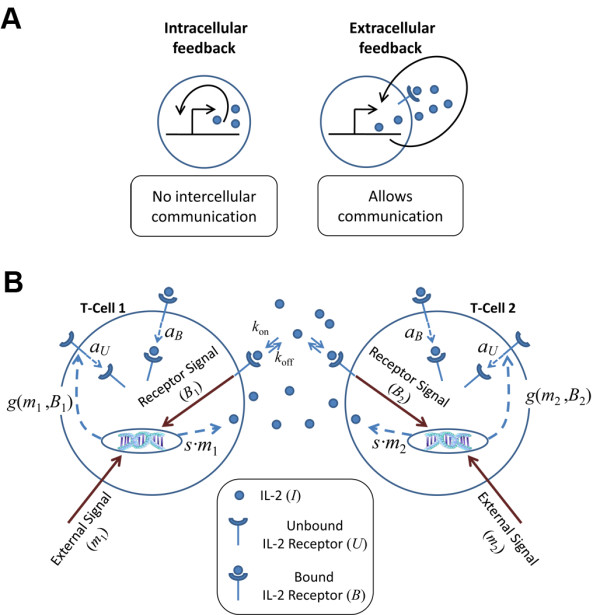Figure 1.

The extracellular feedback module. (A) Extracellular feedback allows for communication between cells. Intracellular feedback (left) relies on sensing a molecule’s level inside the cell. Extracellular feedback (right) relies on sensing the level of a molecule that is secreted to the environment, thus allowing neighboring cells to sense it and engage in the feedback themselves. Sensing the cell’s environment requires receptors, and thus the feedback can modulate the rate of production of the signaling molecule and/or its receptor. (B) Schematics of the IL-2 extracellular feedback system in T-cell activation. T-cells are activated through binding of the T-cell receptors (TCRs) by their cognate peptide-MHC complex. TCR binding induces signals with different strengths, depending on binding affinity and number of bound receptors. Activation signal strength is denoted by m1 and m2 for the two interacting cells. Following TCR signal, the cytokine IL-2 is secreted with a rate that is proportional to the TCR signal level (s·m). In the absence of IL-2, the unbound IL-2 receptor (IL-2R) is generated at a low constitutive rate and is internalized at a rate aU, thus is present in low numbers (~100 molecules per cell). The binding of IL-2 to its receptor causes up-regulation of IL-2R synthesis. The overall IL-2R production rate, g(m, B), depends on the TCR signal strength, m, and on the number of bound IL-2R, B. The IL-2R internalization rate is also increased upon binding of IL-2 (aB). The IL-2 molecule is released to the intercellular space and can be captured by any T-cell. Thus, two processes are in effect: autocrine and paracrine positive feedbacks. These processes allow two nearby T-cells, potentially with different TCR specificities, to communicate and influence each other.
